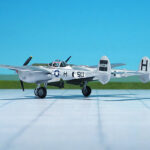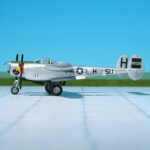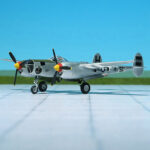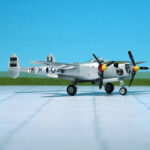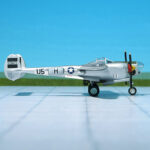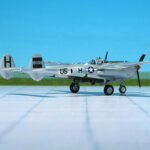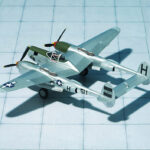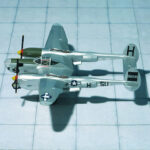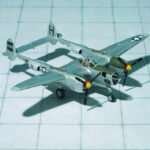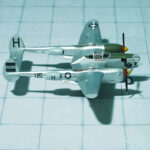TYPE: Fighter bomber
ACCOMMODATION: Pilot and bombardier
POWER PLANT: Two Allison V-1710 (-89 left hand rotation and -91 right hand rotation) liquid-cooled turbo-supercharged piston engine, rated at 1,425 hp each at 26,000 ft
PERFORMANCE: 420 mph
COMMENT: The Lockheed P-38 Lightning was an American single-seat, twin piston-engined fighter aircraft that was used during World War II. Developed for the United States Army Air Corps (USAAC) by the Lockheed Corporation, the P-38 incorporated a distinctive twin-boom design with a central nacelle containing the cockpit and armament. Along with its use as a general fighter, the P-38 was used in various aerial combat roles, including as a highly effective fighter-bomber, a night-fighter, and a long-range escort fighter when equipped withdrop tanks The P-38 was also used as a bomber-pathfinder, guiding streams of medium and heavy bpmbers, or even other P-38s equipped with bombs, to their targets. Used in the aerial reconnaissance role, the P-38 accounted for 90 percent of American aerial film captured over Europe. Although it was not designated a heavy fighter or a bomber destoyer by the USAAC, the P-38 filled those roles and more; unlike German heavy fighters crewed by two or three airmen, the P-38 with its lone pilot was nimble enough to compete with single-engine fighters.
The P-38 Lightning was used most successfully in the Pacific and the China-Burma-India Theaters of Operation. In the South-West Pacific Theater, the P-38 was the primary long-range fighter of USAAF until the introduction of large numbers of North American P-51 Mustangs toward the end of the war.
Like many Second World War fighter aircraft the Lockheed P-38 Lightning soon developed into a formidable fighter bomber, capable of carrying two 2,000lb bombs on internal fuel. This 4,000lb payload was the same as that carried by early Boeing B-17 Flying Fortress bombers or by the de Havilland Mosquito B Mk XVI. However, while the bomber Mosquitoes had a clear nose to aid bomb aiming, the solid nose of the standard P-38 limited the accuracy possible with level bombing.
To meet these requirements the Lockheed P-38 Droop Snoot was developed to act as a bomber leader for formations of standard P-38J or P-38L fighter bombers. The original idea was proposed by two officers based at the 8th Air Force Headquarters. The development work was carried out at Lockheed’s modification centre at Langford Lodge, Northern Island. The key to the Droop Snoot project was the new nose. The guns were replaced by a bombardier/ navigator’s position, with a transparent Plexiglas bubble nose cone similar in profile to that used on the Mosquito, side windows and an emergency hatch. The nose contained a Norden bombsight, the bomb release controls and navigation equipment. It is not entirely clear how many Droop Snoots were produced. Twenty three P-38Js were converted to the new role at Langford Lodge. One hundred conversion kits were also produced for field configuration, but it is not clear how many were used.
Less well known is the second part of the Droop Snoot modification. This was carried out on the other aircraft in a P-38 group, and allowed the bomb aimer in the Droop Snoot aircraft to drop the bombs for an entire group.
The Droop Snoot entered active service on 10 April 1944, when one was used to lead forty-two P-38Js of the 20th Fighter Group against the Luftwaffe base at Gütersloh in Germany. By October 1944 all three P-38 groups in the 9th Air Force were equipped to carry out Droop Snoot missions.
Lockheed P-38 Droop Snoot Lightnings could be found serving from bases in Britain and Italy throughout the rest of the war in the European Theater (Ref.: 24).

